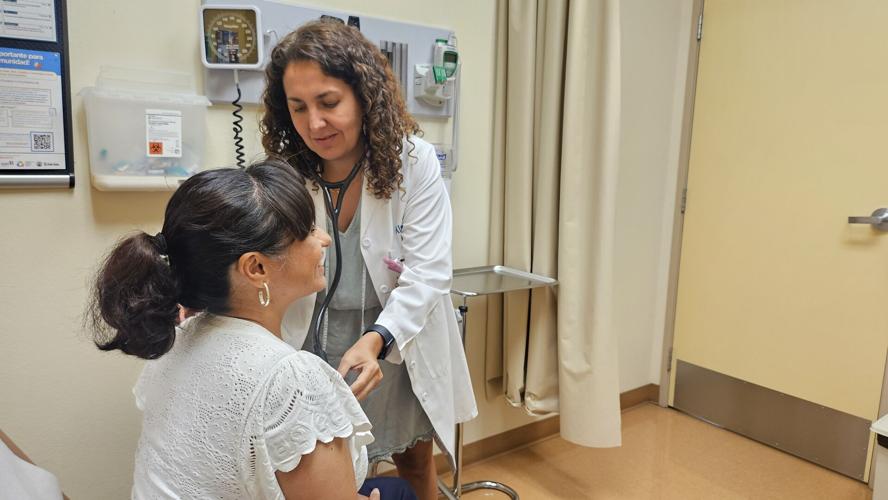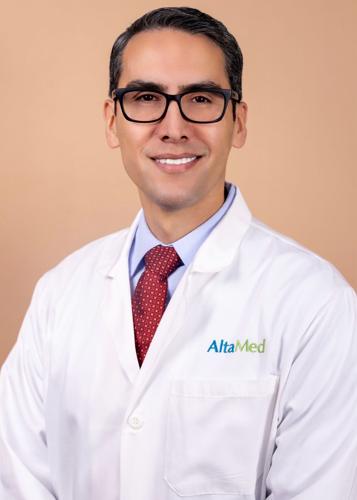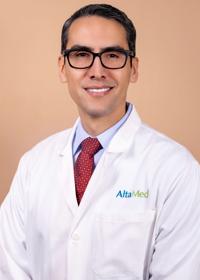
Doctor Laura Castro Castrezana works in AltaMed Medical Group in Huntington Park. (Photo by Jacqueline García)
In areas with a large Latino population, like the East and Southeast sides of Los Angeles, it is often difficult to find doctors who can speak the language and understand the culture.
For many Latinos, going to the doctor is intimidating due to the barrier of language. However, a new pilot program is trying to change this narrative in California. The Licensed Physicians from Mexico Pilot Program (LPMPP) allows physicians with a medical license from Mexico to practice at community health centers in California. The goal is to meet the cultural and linguistic needs of the Latino patient population while expanding access to quality healthcare services.
LPMPP was introduced as AB 1045 in 2001 by the late Assemblyman Marco Antonio Firebaugh and passed in 2002. However, it took 20 years for the bill to take effect due to logistics, such as the recruitment process, visa approval, licensing in California and other factors. Once approved, 30 physicians with a medical license from Mexico were able to practice at one of California's Community Health Centers (CHCs) for a period of three years.
Existing law requires the Medical Board of California to oversee the program to ensure that provisions are being followed.
Doctors experience the migrant culture
Under this program, AltaMed was selected as one of these centers in Southern California, with seven of the 30 doctors working at its clinics in Los Angeles and Orange County.
One of them is Christopher Wissar Acosta, a family medicine specialist who applied for the program in 2017 and started working at AltaMed Medical and Dental Group in West Covina in January 2023.
Acosta, 42, originally from Chihuahua, Mexico, said that while patients in California and Mexico have the same health conditions, the difference is that in California, there is more access to better-quality drugs.
While working here, Acosta not only does physical checkups and prescribes drugs, but he has also learned more about the struggle of the Latino and immigrant communities. He said patients often don’t go only to talk about their physical health, but also about their emotional health. They feel comfortable being able to express themselves with the doctor in the same language, without translators.
"In Mexico, I was a private practice doctor, but with this program, I learned the importance of the language and how much you can help people," he said. "Some of them have been here for decades and they always feel like a guest in this country."

Doctor Christopher Wissar Acosta works in AltaMed Medical and Dental Group in West Covina. (Photo courtesy of AltaMed)
Doctors who were accepted in the pilot program were given the option to bring their immediate families. Acosta did not, but his wife and daughter visit him.
He said that one time, while his daughter was here, they were driving and saw some farm workers working when the temperature was high. Acosta taught his daughter a valuable lesson about respecting people, which he calls invisible heroes.
According to the American Association of Medical Schools, in 2019, only 5% of medical school graduates identified as Latino. At this rate, it is estimated that the United States will have a shortage of primary care physicians between 21,000 and 55,000 by 2033.
This is why programs such as LPMPP are vital for the Latino community in the United States.
Laura Castro Castrezana is another Mexican doctor in the pilot program. She has been working in internal medicine for the past 12 years in Mexico City and learned about the program in 2015. After getting accepted in 2022, she started working at AltaMed in Huntington Park in February 2023.
She said that while the work is the same in both countries, she is impressed by the U.S. system.
"The public hospitals in Mexico have fewer resources and the patient records system here is more efficient," she said.
Castrezana, 45, said when she started at AltaMed she would see a mixture of patients of all ages. However, she feels more comfortable seeing older patients than healthy young ones. She feels her experience is utilized more when she is able to treat Spanish-speaking patients who feel more comfortable expressing their concerns in the same language.
"As Latinos, we have regional slang and only when you are speaking the language can you understand specifics," she said. "This motivates them to continue attending their doctor appointments."
Both Acosta and Castrezana have their medical license valid in the U.S. until 2025.
The bills that could help Spanish-speaking patients
The pilot program sent the other 23 Mexican doctors to Central California in Altura Centers for Health in the San Joaquin Valley, Clinica de Salud del Valle de Salinas and San Benito Health Foundation in Hollister.
Per the Medical Board of California's request, since 2021, an evaluation of the LPMPP has been conducted by UC Davis to make recommendations on whether it should continue, expand, be altered or terminated. So far, the program has received positive remarks from the community and organizations at large.
And because AB 1045 was approved as a three-year pilot program and has been of great help, there are two additional bills in progress that could help expand it.
AB 2864 aims to extend the doctors' stay for another three years, and AB 2860 intends to make the pilot program official in the state so more Mexican doctors can practice medicine for longer periods of time.
Daniela Barcenas, project coordinator for the seven doctors at AltaMed, said this program is extremely important because California has a large Latino population, but the number of physicians doesn't match the need.
According to the California Health Care Foundation, about 40% of the population in California is Latino, but only 5% of doctors identify as Latinos.
"We have seen our patients feel more comfortable meeting with physicians that speak their language and understand their cultural background and practices at home," said Barcenas.
She said this pilot program matches AltaMed's goal of closing the equity gap in healthcare needs among Latinos.
Barcenas said she constantly contacts the Mexican doctors because while they are experts in their medical field, they also need guidance to navigate the system, acclimate to a new country and deal with culture shock.
Once the doctors received their three-year license from the California Medical Board and a work visa, they were required to complete a six-month orientation course approved by the board. This orientation teaches them California's health care delivery system and protocols.
Both bills, AB 2864 and AB 2860 were reviewed this week. AB 2864 passed on Monday, August 26, with bipartisan support. AB 2860 passed on Tuesday August 27, with bipartisan support. Both bills are headed to Governor Gavin Newsom’s desk for his signature.













(0) comments
Welcome to the discussion.
Log In
Keep it Clean. Please avoid obscene, vulgar, lewd, racist or sexually-oriented language.
PLEASE TURN OFF YOUR CAPS LOCK.
Don't Threaten. Threats of harming another person will not be tolerated.
Be Truthful. Don't knowingly lie about anyone or anything.
Be Nice. No racism, sexism or any sort of -ism that is degrading to another person.
Be Proactive. Use the 'Report' link on each comment to let us know of abusive posts.
Share with Us. We'd love to hear eyewitness accounts, the history behind an article.